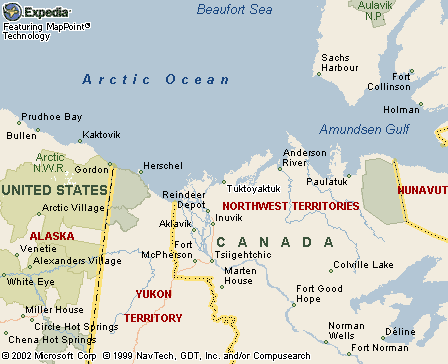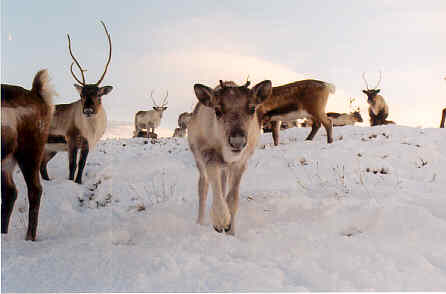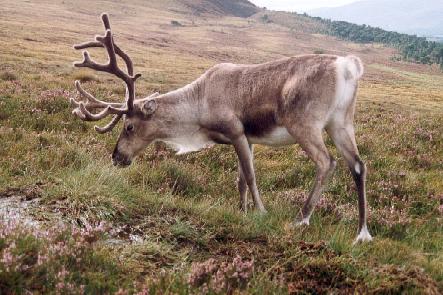|
|
Canku Ota |
|
|
(Many Paths) |
||
|
An Online Newsletter Celebrating Native America |
||
|
May 18, 2002 - Issue 61 |
||
|
|
||
|
Memories of a Reindeer Herder - Jimmy Komeak |
||
|
credits:{credits}
|
|
Mr. Jimmy Komeak, who is 63 years of age,
is an active elder of the community of Tuktoyaktuk. Mr. Komeak is
originally from the Cambridge Bay area. He attended only three years
of school in Aklavik from 1938 to 1941. After finishing school,
he moved back to Cambridge Bay where he obtained employment as a
Special Constable for the local RCMP detachment as a translator.
In the summer of 1942, he and his brother Joseph traveled back to
the west to Tuktoyaktuk on a small boat called the Nigilik, which
was owned by the trading company Con Alaska. The fall of that same
year, Jimmy got involved with reindeer herding which he continued
in this occupation for 13 years.Jimmy got married to his wife Jean
in the year 1950. They had seven children of which five are living. Over the years, Jimmy has held various
occupations after he quit reindeer herding in 1956. For a year he
worked for the RCMP in aklavik, the Hudson Bay Company in Tuktoyaktuk,
various Dew (Distant Early Warning) site, Community Health Worker
for the local nursing station, outreach worker, delegate for the
Metis Association, and harbour monitor during the 1970s and 80s
oil exploration boom in the Western Arctic. Presently, Jimmy is
an active member of the BACKGROUND In trying to find solutions to aid the
people of the region, in 1919, "the Canadian government of
reindeer and muskox husbandry on northern Canada (Sims, 1983)".
The primary reason was to aid the people with another source of
food since the caribou in the region had disappeared leading up
to the 1930s. The reasons for this disappearance of caribou stated
by DIAND (1983) might have been "the increasing use of the
rifle for hunting by Eskimo and a growing presence by man native
and non-native in the north". Therefore, the initial intention
of the government was" it thought that bringing in reindeer
to replace the caribou and turning some hunters and trappers into
herdsmen might be a solution. Herding could provide wages for local
inhabitants, and the herd, which would gradually increase, would
provide meat and hides to the local communities (Renewable Resources,
1989)". However, before a herd could be established,
a survey needed to be conducted to determine if there was sufficient
rangelands to sustain a viable herd. Therefore, during the years
of 1927/28, a survey was conducted between the Alaska, Yukon and
Coppermine River by A.E. Porild and his brother. After this preliminary
rangelands survey, it was assessed that the lands east of the Mackenzie
Delta were excellent for establishing a reindeer herd. In 1929, the Canadian government obtained 3,000 head of reindeer from the Lomen Reindeer Company of Alaska. "The reindeer drive took six winters and five summers to complete. Over terrain which few people had traveled before or since, the herders had to deal with inclement weather, accidents, impassable mountain ranges, wolf predation, personal conflicts, and straying reindeer (Renewable Resources, 1989)". They reached the Mackenzie Delta in 1935 with a population of 2,382 head of reindeer. INITIAL START UP Jimmy Komeak began reindeer herding for the federal government in the fall of 1942. How he came to manage his own herd was because of his organizational skills and his ability to speak his own language and as well the English language. Jimmy and Guy Omagotuk, a local from the Mackenzie Delta, were in partnership for a herd of 800 reindeer. MANAGEMENT The herd Jimmy and Guy were allocated had two employed herdsmen for the management of the herd. They usually kept a 24-hour watch on the herd, more so in the spring and fall. They followed and kept the herd together throughout most seasons, feeding in an area for at least three months at a time. The cycle. They followed were based on seasonal movement patterns that they followed from year to year. The seasonal cycle for Jimmy's herd were:
Besides the main herd, which was stationed at Richards Island, there were four Inuit-owned herds when Jimmy was herding his own herd. In the beginning, there were six Inuit-owned herds, but due to "an unfortunate accident" the first two herds reverted back to the government in 1944 when the owners and their families drowned in a storm in the Beaufort Sea (Renewable Resources, 1989". The families were of Charlie Kidley and Peter Kuglik. The rangelands Jimmy grazed his herd on ware an area called Toker Point on the Tuktoyaktuk peninsula. With his herd, he ranged from the Toker Point area to the Husky Lakes area (current maps indicate Eskimo Lakes).The other three Inuit-owned herds were located and managed by:
The mode of transportation, as Jimmy indicates,
"them days you had to be tough" since most of the traveling
was done on foot. During the winter months most of the travel was
done on skis, which were introduced by the Lapp herders, who brought
the initial herd to the Mackenzie Delta. When needing to travel
on water, they utilized scows (flat-bottomed boats). They also used reindeer for carrying supplies
and transportation purposes. The training of reindeer was quite
young. They had to train the reindeer to respond to commands and
get used to the harnesses and packs. They tried riding the reindeer
like horses, but the reindeer could not handle the weight of the
rider over rough terrain. They also became dependent on dogs, but
more so for the gathering and herding of the reindeer. These dogs
were brought over with the initial reindeer herd. They were a breed
of collie, the type used by sheepherders. Each herder had to train
their own herd dogs to respond to commands of whistles. They were
efficient at long distances. The use of these dogs made herding
the reindeer easier. When they had to travel long distances during
the winter months, they used dog teams. Payment for supplies or other necessities
was usually based on a barter system reindeer meat for supplies.
For example, on one of the grazing areas, Jimmy and crew needed
a base camp from which to operate from. A deal between the owner,
Jonah Carpenter, who owned a small log cabin, was made for the trade
of two reindeer. The slaughtering of reindeer took place
once a year, usually before Christmas. Most of the meat was sold
to the residential school in Aklavik. Family life for a herder was a life where the majority of the time was spent out tending the herds. The time they spent with their families was around the Christmas holidays, spring and summer. CONCLUSION The herding technique Jimmy and other
Inuit herders were using to manage their herds has come to be called
the "closed herding technique" which is successfully used
in other reindeer-herding countries, but in the Mackenzie Delta/Beaufort
Sea area, in the long run proved unreliable. Eventually, what Jimmy
and his herd were experiencing; the other herders were facing the
same problems. As Sims (1983) indicates "it is now believed
that attempts failed for a The significance of this information in relation to the study of anthropology and to the history of the Northwest Territories is an attempt by the federal government to turn nomadic hunters into domesticated herders. Their attempt was fruitful, but for unforeseen circumstances was unsuccessful. As Jimmy Komeak says, "those were the days, life was good, but we will never see those days again". |

|
www.expedia.com |
|
|
||
|
|
||
| Canku Ota is a free Newsletter celebrating Native America, its traditions and accomplishments . We do not provide subscriber or visitor names to anyone. Some articles presented in Canku Ota may contain copyright material. We have received appropriate permissions for republishing any articles. Material appearing here is distributed without profit or monetary gain to those who have expressed an interest. This is in accordance with Title 17 U.S.C. Section 107. | ||
|
Canku Ota is a copyright © 2000, 2001, 2002, 2003 of Vicki Lockard and Paul Barry. |
||
 |
 |
|
|
The "Canku Ota - A Newsletter Celebrating Native America" web site and its design is the |
||
|
Copyright © 1999, 2000, 2001, 2002, 2003 of Paul C. Barry. |
||
|
All Rights Reserved. |
||
 The
following is an excerpt from a research paper written by Charles
Klengenberg back in 1983 through an interview with Jimmy Komeak
about his time spent as a reindeer herder near Tuktoyaktuk.
The
following is an excerpt from a research paper written by Charles
Klengenberg back in 1983 through an interview with Jimmy Komeak
about his time spent as a reindeer herder near Tuktoyaktuk.  The
management of the herd was based on a five-year plan, in which Jimmy
and his partner were to sustain, multiply and become self-sufficient
with a thriving reindeer herd. The strategy of the government at
the time were "from the main herd, smaller herds were to split
off and become the property of Inuit herdsmen, who would eventually
repay reindeer into the main herd as their own stock increased (Renewable
Resources, 1989)". For initial supplies, Jimmy and crew were
assisted by the government to aid them in the day-to-day management
of the herd, especially when they first started out.
The
management of the herd was based on a five-year plan, in which Jimmy
and his partner were to sustain, multiply and become self-sufficient
with a thriving reindeer herd. The strategy of the government at
the time were "from the main herd, smaller herds were to split
off and become the property of Inuit herdsmen, who would eventually
repay reindeer into the main herd as their own stock increased (Renewable
Resources, 1989)". For initial supplies, Jimmy and crew were
assisted by the government to aid them in the day-to-day management
of the herd, especially when they first started out. Each
herding group would graze in an area for at least three months,
since the reindeer, in comparison to caribou, are less migratory.
Each
herding group would graze in an area for at least three months,
since the reindeer, in comparison to caribou, are less migratory.